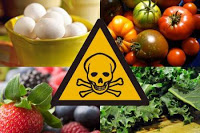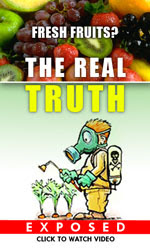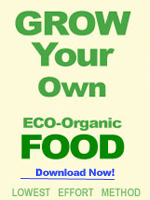 |
| image source |
Brandon Turbeville
Activist Post
In my past few articles, I have discussed the documented adverse health effects related to pesticide use,[1] the difference between general pesticides and POPs[2] (Persistent Organic Pollutants), and the requirements that must be met [3]in order for the designation of POP to be applied to a specific pesticide.
With all of this in mind, one may be surprised that Codex Alimentarius actually allows for the presence of such dangerous chemicals in food. Before explaining this position, however, it is important to note some of the background regarding POPs, the Stockholm Convention, and, finally, the Codex Alimentarius POP guidelines themselves.
In 2001, The Stockholm Convention on Persistent Organic Pollutants was adopted with the stated goals of eliminating or reducing the production and use of POPs. The Stockholm Convention entered into force in 2004 and is overseen by the United Nations Environment Program. The Conference of the Parties of the Stockholm Convention (COP) manages the POPs Convention with each of the members of the Stockholm Convention being the members of the COP. The function of the members of the Convention is to implement the obligations of the treaty at the national level.
Although 50 countries have ratified the treaty, the U.S. is not one of them. However, the U.S. has largely begun to implement the treaty on the national level. This has been accomplished through a series of national laws and other international agreements.
Since 1972, the United States and Canada have signed several agreements involving the removal of POPs from the Great Lakes such as the Great Lakes Water Quality Agreement and the Great Lakes Binational Toxics Strategy. The U.S. is also party to the Rotterdam Convention on the Prior Informed Consent Procedure for Certain Hazardous Chemicals and Pesticides in International Trade with 71 other countries and the European Union.
On a national level, the U.S. has passed four major laws that involve the ban or restriction of POPs. The Federal Insecticide, Fungicide, and Rodenticide Act (FIFRA), the Toxic Substances Control Act (TSCA), the Clean Air Act (CAA), and the Clean Water Act (CWA).
Below is a brief synopsis of the 12 main POPs and their status in the United States in terms of how they are regulated by law.[4]
Aldrin and Dieldrin
Insecticide on corn and cotton; termite control
FIFRA
- No registrations in U.S.
- Most uses canceled in 1969.
- All uses canceled by 1987.
- All tolerances on food crops revoked in 1986.
No production, import, or export allowed.
Chlordane
 Insecticide on various crops including vegetables, small grains, potatoes, sugarcane, sugar beets, fruits, nuts, citrus, and cotton. Home and garden pests. Termite control.
Insecticide on various crops including vegetables, small grains, potatoes, sugarcane, sugar beets, fruits, nuts, citrus, and cotton. Home and garden pests. Termite control.
FIFRA
- No registrations in U.S.
- All tolerances on food crops revoked in 1986.
- Regulated as a hazardous air pollutant.
No production, import, or export allowed.
DDT
Insecticide on agricultural crops, especially cotton. Insects that carry malaria and typhus.
FIFRA
- No registrations in U.S.
- Most uses canceled in 1972.
- All used canceled in 1989.
- Tolerances on food crops revoked in 1986.
- DDE (a metabolite of DDT) regulated as a hazardous air pollutant.
- Considered a priority toxic pollutant.
Endrin
Insecticide on crops such as cotton and grain. Rodent control.
FIFRA
- No U.S. registrations.
- Most uses canceled in 1979.
- All uses canceled by 1984.
- Priority toxic pollutant.
No production, import, or export allowed.
Mirex
Insecticide for fire ants, termites, and mealy bugs. Used as a fire retardant in plastics, rubber, and electrical products.
FIFRA
- No U.S. registrations.
- All uses canceled in 1977.
No production, import, or export allowed.
Heptachlor
Insecticide for soil insects and termites. Used against some crop pests and insects that carry malaria.
FIFRA
- Most used canceled by 1978.
- All pesticide tolerances on food crops revoked in 1989.
No production, import, or export allowed.
Hexachlorobenzene
 Fungicide used for seed treatment. An industrial chemical used in the production of fireworks, ammunition, synthetic rubber, and other products. Unintentionally produced during combustion and the manufacture of certain chemicals. An impurity in certain other pesticides.
Fungicide used for seed treatment. An industrial chemical used in the production of fireworks, ammunition, synthetic rubber, and other products. Unintentionally produced during combustion and the manufacture of certain chemicals. An impurity in certain other pesticides.FIFRA
- No U.S. registrations.
- All uses canceled by 1985.
- Regulated as a hazardous air pollutant.
- Priority toxic pollutant.
No production, import, or export allowed.
Approved for manufacture and use for chemical intermediate (allowed under the Convention).
PCBs
Various industrial functions such as electrical transformers and capacitors, heat exchange fluids, paint additives, carbonless copy paper, and plastics. Unintentionally produced during combustion.
TSCA
- Manufacture and new use prohibited in 1978.
- Regulated as a hazardous air pollutant.
- Priority toxic pollutant.
Toxaphene
Insecticide used to control pests on crops and livestock. Used to kill unwanted fish in lakes.
FIFRA
- No U.S. registrations.
- Most uses canceled in 1982.
- All uses canceled by 1990.
- All tolerances on food crops revoked in 1993.
- Regulated as a hazardous air pollutant.
No production, import, or export allowed.
 Dioxins and Furans
Dioxins and Furans
Unintentionally produced during most forms of combustion involving the burning of medical and municipal waste, household waste, and industrial processes. Found as “trace contaminants” in certain herbicides, wood preservatives, and PCB mixtures.
CAA
- Regulated as hazardous air pollutants.
- Dioxin in the form of 2, 3, 7, 8-TCDD is a priority toxic pollutant. [5]
In this regard, we now arrive at one of the more baffling instances of the Codex Alimentarius global guideline machine. While it is well known that pesticides are becoming increasingly permissible and accepted all across the world, it is quite predictable that Codex would allow a vast majority of them to exist as residues in food. Yet POPs, which are banned or restricted by not only national laws but international agreements as well, are also allowed to reside in food.
It is not at all surprising that Codex would disregard national laws. This is common practice. Yet to fly in the face of international agreements is quite another matter, especially agreements formulated by the very organizations that played such a vital role in the creation of Codex. But this is, in fact, the case.
We are witnessing an ordinary mode of function in the process of incrementalism – in this situation, the incremental creation and establishment of a one world government. Indeed, many instances of tyranny begin with benefits early on. In this case, the benefit of signing treaties under the auspices of the United Nations has produced some relevant and positive results – the banning and restriction of POPs.
However, as nations move further and further along this road and the UN begins to show its true colors, the relevance of these treaties will be diminished and the new global bodies such as Codex Alimentarius will begin to change the very few agreements that have done any good in the world and push forward in the direction of a global structure of corporate dominance. The previous benefit of the international agreement(s) are destined to exist only temporarily.
An example of this can be seen clearly within the Codex Committee on Pesticide Residues in comparison with U.S. law. As expressed in the summary provided above, the United States has eliminated the registration of most POPs for use inside the country and has revoked tolerances for many of these substances in food.
Codex, however, has done exactly the opposite. In the face of both national law and international agreements to the contrary, the Codex Committee on Pesticide Residues (CCPR) and subsequently the Codex Alimentarius Commission permits seven of the original twelve POPs to exist as residues in food.
Even though these substances have been banned virtually the world over, the fact that Codex allows them to exist in food suggests to many that the door is open to reversing this position once Codex is firmly in place as a regulatory standard.[6] Nevertheless, even if these suspicions are proven to be baseless, the very fact that Codex allows for the existence of POPs in food should be alarming enough.
In reference to the Codex guidelines, it is important to note that while the upper limits set on the residues of non-POP pesticides are labeled as Maximum Residue Limits (MRL), the labeling is slightly different for POP residues. For these chemicals, the designation is Extraneous Maximum Residue Limits. However, this distinction is merely semantics, as the supposedly “extraneous” MRLs are not very different from the common MRLs used for non-POP pesticides. Indeed, the limits imposed upon POPs in food are barely distinguishable from those set for any other pesticide residue.
 |
| 90,000 heirloom seeds for $95 44,500 seeds for $48 |
The values are expressed as mg/kg (ppm) and reflect the same level of concern as any other chemical evaluated by Codex. So the use of the term “extraneous” is, itself, misleading as it implies that the presence of POPs in food will be so small as to warrant no concern. Yet the fact that these EMRLs have to be set in the first place, and set so high, contradicts this intended assumption.
Nevertheless, EMRLs have been set for seven of the 12 original POPs banned by the Stockholm Convention and U.S. law. They include DDT, Endrin, Heptachlor, Chlordane, Aldrin, Dieldrin, and Hexachlorobenzene.
Currently, the EMRL for each chemical has not been evaluated for every food substance that it might contaminate, yet the commodities that have been examined and the subsequent EMRLs established for them do not bode well.
For instance, DDT EMRLs are set at .2 ppm for carrots, .1 for cereal grains, .3 for poultry meat and a whopping 5 for meat with the exception of marine mammals.[7] Similar levels are established for Endrin, which is 2-4 times more toxic than DDT.[8] Indeed, this is the pattern for six of the seven POPs allowed in food under Codex guidelines. Observe the data presented below:
Please note: for the purpose of this discussion, the values of ppm (parts per million) will be used. Although Codex uses values in mg/kg, these values are easily converted to the equivalent of the mg/kg in terms of ppm.
DDT
Carrot = 0.2 ppm; Cereal Grains = 0.1 ppm; Eggs = 0.1 ppm; Meat (mammals other than marine mammals) = 5 ppm; Milk = 0.02 ppm; Poultry Meat = 0.3 ppm
Endrin
Fruiting Vegetables/Cucurbits = 0.05 ppm; Poultry Meat = 0.1 ppm
Aldrin
Bulb Vegetables = 0.05 ppm; Cereal Grains = 0.02 ppm; Citrus Fruits = 0.05 ppm; Eggs = 0.1 ppm; Fruiting Vegetables/Cucurbits = 0.1 ppm; Leafy Vegetables = 0.05 ppm; Legume Vegetables = 0.05 ppm; Meat (mammals other than marine mammals) = 0.2 ppm; Milk = 0.0066 ppm; Pome Fruits = 0.05 ppm; Poultry Meat 0.2 ppm; Pulses = 0.05 ppm; Root and Tuber Vegetables 0.1 ppm;
Dieldrin
Bulb Vegetables = 0.05 ppm; Cereal Grains = 0.02 ppm; Citrus Fruits = 0.05 ppm; Eggs = 0.1 ppm; Fruiting Vegetables/Cucurbits = 0.1 ppm; Leafy Vegetables = 0.05 ppm; Legume Vegetables = 0.05 ppm; Meat (mammals other than marine mammals) = 0.2 ppm; Milk = 0.006 ppm; Pome Fruits = 0.05 ppm; Poultry Meat = 0.2 ppm; Pulses = 0.05 ppm; Root and Tuber Vegetables = 0.1 ppm
Heptachlor
Cereal Grains = 0.02 ppm; Citrus Fruits = 0.01 ppm; Cotton Seed = 0.02 ppm; Eggs = 0.05 ppm; Meat (mammals other than marine mammals) = 0.2 ppm; Milk = 0.006 ppm; Pineapple = 0.01; Poultry Meat = 0.2 ppm; Soya Bean (immature seeds) = 0.02 ppm; Soya Bean Oil, Crude = 0.5 ppm; Soya Bean Oil, Refined = 0.02 ppm
Chlordane
Almonds = 0.02 ppm; Cotton Seed Oil, Crude = 0.05 ppm; Eggs = 0.02 ppm; Fruits and Vegetables = 0.02 ppm; Hazelnuts = 0.02 ppm; Linseed Oil, Crude = 0.05 ppm; Maize = 0.02 ppm; Meat (mammals other than marine mammals) = 0.05 ppm; Milk = 0.002 ppm; Oats = 0.02 ppm; Pecan 0.02 ppm; Poultry Meat = 0.5 ppm; Rice, polished = 0.02 ppm; Rye = 0.02 ppm; Sorghum = 0.02 ppm; Soya Bean Oil, Crude = 0.05 ppm; Soya Bean Oil, Refined = 0.02 ppm; Walnuts = 0.02 ppm; Wheat = 0.02 ppm;
While some might argue that the levels permitted for these substances by the CCPR are so low that they should warrant no concern, the fact is that there should be no levels of any of these substances in food at all. Setting EMRLs for these pesticides only serve to legitimize their consumption as well as their potential reintroduction to the food supply and the environment.
 However, what may cause more concern than accepting levels of POPs in food is the lack of an EMRL for certain substances among the establishment of EMRLs for others. Indeed, this is the case for many general pesticides as well as some POPs.[9] If Codex were to establish an EMRL for particular hazardous chemical such as Hexachlorobenzene, the situation would be bad enough. If it were to simply ignore the question of EMRLs for a whole group of substances and claim neutrality, one might be alarmed but at least the logic would be consistent.
However, what may cause more concern than accepting levels of POPs in food is the lack of an EMRL for certain substances among the establishment of EMRLs for others. Indeed, this is the case for many general pesticides as well as some POPs.[9] If Codex were to establish an EMRL for particular hazardous chemical such as Hexachlorobenzene, the situation would be bad enough. If it were to simply ignore the question of EMRLs for a whole group of substances and claim neutrality, one might be alarmed but at least the logic would be consistent.
However, in a situation in which Codex sets EMRLs for at least one substance, the lack of an EMRL effectively lifts the ceiling on the levels that might be present in the food. For this reason, only an EMRL of 0 is acceptable. Indeed, it is only an EMRL of 0 that prohibits the contamination of food from pesticide residues.
Of course this concern is not isolated to POPs. As of 2007, Codex had assessed over 185 different pesticides and established over 3,275 MRLs[10] and this issue applies to many general pesticides as well. Pesticides such as Bromophos, Carbon Disulphide, and many others have no MRLs set for them, even though many of their counterparts do.[11] For those that do have limits imposed upon them, they are often different from EPA limits, some being set much higher and some much lower.
Ultimately, however, the MRLs set by the EPA will be irrelevant, as they are to be harmonized with the Codex limits anyway. After all, harmonization of all national laws with the standards set by Codex Alimentarius are the stated goals of both Codex and various agencies of the U.S. Federal Government, about which I will comment on in the next article in this series.
Notes:
[1] Turbeville, Brandon. “Multiple Scientific Studies Link Pesticides To Cancer.” Activist Post. June 5, 2013. https://www.activistpost.com/2013/06/multiple-scientific-studies-link.html Accessed on July 1, 2013.
[2] Turbeville, Brandon. “Pesticide Content in Food Less Regulated by Codex Than Vitamins and Minerals.” Activist Post. May 20, 2013.https://www.activistpost.com/2013/05/pesticide-content-in-food-less.html Accessed on July 1, 2013.
[3] Turbeville, Brandon. “The Global Threat of Persistent Organic Pollutants.” Activist Post. June 24, 2013. https://www.activistpost.com/2013/06/the-global-threat-of-persistent-organic.html Accessed on July 1, 2013.
[4] Abelsohn, Alan., Gibson, Brian L., Sanborn, Margaret D., Weir, Erica. “Identifying and managing adverse environmental health effects:5. Persistant Organic Pollutants.” Canadian Medical Association Journal. June 11, 2002. 166 (12). http://www.cmaj.ca/cgi/content/full/166/12/1549 Accessed May 24, 2010.
[5] Ibid.
[6] Pesticide Residues In Food. Codex Alimentarius. www.codexalimentarius.net
[7] Pesticide Residues In Food. www.codexalimentarius.net http://www.codexalimentarius.net/mrls/servlet/PesticideServlet?Pesticides=21&Items=0&out_style=by+substance&Domain=PesticideMRLs&Language=english&query_form=%2Fmrls%2Fpestdes%2Fpest_q-e.htm Accessed 4/5/2010.
[8] “Codex Allows Deadly Pesticides.” Global Healing Center. http://www.globalhealingcenter.com/phpprint.php
[9] Pesticide Residues In Food. Codex Alimentarius. www.codexalimentarius.net Accessed May 20, 2010.
[10] “Codex Committee on Pesticide Residues (CCPR)” Consumers International. http://www.consumerinternational.org/templates/internal.asp?NodeID=94886 October 8, 2007. Accessed April 6, 2010.
[11] “Pesticide Residues In Food.” Codexalimentarius.net http://www.codexalimentarius.net/mrls/pestdes/jsp/pest_q-e.jsp
Read other articles by Brandon Turbeville here.
Brandon Turbeville is an author out of Florence, South Carolina. He has a Bachelor’s Degree from Francis Marion University and is the author of three books, Codex Alimentarius — The End of Health Freedom, 7 Real Conspiracies, and Five Sense Solutions and Dispatches From a Dissident. Turbeville has published over 200 articles dealing on a wide variety of subjects including health, economics, government corruption, and civil liberties. Brandon Turbeville’s podcast Truth on The Tracks can be found every Monday night 9 pm EST at UCYTV. He is available for radio and TV interviews. Please contact activistpost (at) gmail.com.
var linkwithin_site_id = 557381;
linkwithin_text=’Related Articles:’


Be the first to comment on "Codex Alimentarius Permits a Wide Range of Dangerous Chemicals in Food"